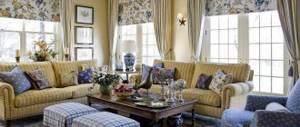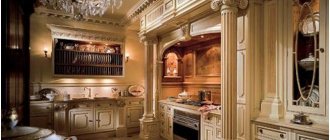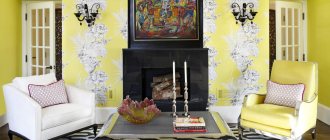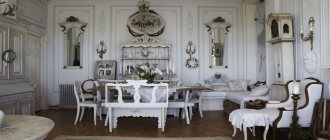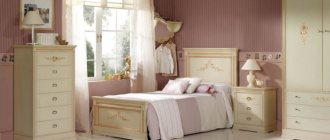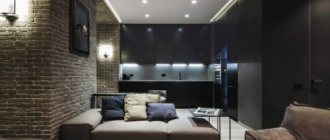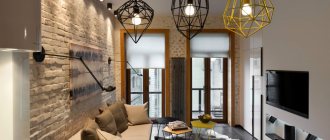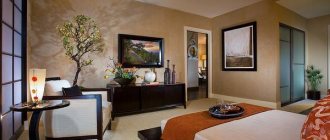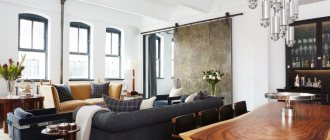Whether you've been to Bavaria in person or just seen a picturesque photograph of those places, the cozy atmosphere of a German home can attract attention and make you want to recreate it in your own home.
Known throughout the world for its Oktoberfest beer festival, painted clay beer steins, fine Bavarian porcelain and the Alps, this picturesque land can inspire Bavarian-style interior decorating with understated yet elegant German charm .
Furniture
Most houses in Bavaria are furnished with wooden furniture, decorated with curlicues and hand-painted patterns. Choose furniture with characteristic decorative elements: rounded corners, carvings and legs made in the shape of animal paws . Place a sofa and armchairs covered in velvet in the living room, and a separate wardrobe in the bedroom.
Find space for a large glass cabinet in which you can display Bavarian porcelain, pewter dishes or beautiful painted beer mugs. Go to antique stores to find authentic Bavarian furniture, or buy reproductions for much less.
Features inherent in the German style
The first thing that the average person will remember about the style of houses in Germany is that most of them are stylized as half-timbered, which translated means “a structure made of sections.” As a rule, it has several floors, the lower of which is the most powerful, since it is made of stone or brick. The upper tiers are a wooden frame filled with straw or clay. A distinctive feature is that this frame is visible both from the outside and from the inside of the building.
Many experts call the Bavarian style a shining example of true pragmatism. This, however, does not mean abandoning the aesthetic component. Not at all: the aesthetics of a minimalist approach to this issue is visible in literally every detail.
Let's highlight a few details that you will definitely pay attention to in a burgher's house:
- There is nothing in the room that is not used by residents. You will not find a single unnecessary detail or piece of furniture in the rooms;
- all lines are clear, all functions of objects are absolutely clear;
- each item is endowed with a specific functionality, and its design has an embodiment that is completely appropriate for its purpose;
- the furniture is practical, arranged strictly in accordance with the needs of the inhabitants of the house;
- the decor is not as ornate as, say, in French rooms.
If we delve deeper into the theoretical part, then in the style of German premises we can distinguish three directions:
- historical stylistics – Biedermeier;
- country (“half-timbered” is precisely its most famous variety);
- modern style.
The period of Biedermeier's emergence is considered to be the beginning of the 19th century. It reflected the desire of the Germans to take refuge in the comfort of home from the instability in the political sphere, which at that time gripped the European part of the continent. It was based on the luxurious, romantic Empire style, which quickly became loved by the middle class. In their desire to transform housing in the manner of German palaces, the townspeople overloaded it with furniture, luxury goods, or their imitation.
The apartment in German country style is distinguished by its good quality, neatness and quality.
The carelessness that is inherent in this style in other countries is completely absent here. But modernism in Germany is strict and elegant. He absorbed the features of Biedermeier and country music, diluting them with elements of modernity.
The layout of a German home is very simple: there are no arches, niches, podiums, or imitations of fireplaces. There is no room for stucco molding, pilasters, cornices, or ceiling rosettes.
But there is a lot of light that large windows let into the house. And there are a lot of them in the room. By the way, window blocks in the ceiling were also invented by the Germans, spurred by the desire to let as much sunlight into the room as possible.
Floor
In the interiors of Bavarian houses you can often see beautiful solid wood floors . If by chance you covered a wooden floor with carpet, tear it off, sand and polish the wooden boards and cover it with stain or just varnish.
Place several small floral-patterned rugs in strategic places or layer colorful patchwork rugs and secure them to the floor with double-sided tape.
Subjects
One of the most popular themes for Bavarian interiors is Oktoberfest. Arrange clear glasses or painted clay mugs in a row on a wooden shelf above the fireplace and complement them with figurines of men and women in traditional ethnic attire - a dress with a tight bodice and a wide gathered skirt or knee-length pants.
Or you can recreate the look of a Bavarian chalet, especially if the room has a fireplace. Install dark wood beams, real or imitation, on the ceiling, and hang framed paintings depicting scenes from the Bavarian countryside. You can use authentic photographs or beautiful tourist posters.
Decorative elements
It is customary to decorate the interior in the Bavarian style with collectible trinkets. You can collect a collection of Hummel figurines and display them on a shelf or in a glass cabinet. These amazing figurines of boys and girls dressed in traditional clothes and living their lives can be found in many German homes, but especially in Bavaria, where they come from.
Photo gallery:
Shabby Chic style - continuing the traditions of the Provence style Interior in the Moorish style Art Deco style in the interior of rooms Futurism in interior design
bavarian house
October 22, 2012
To fully maintain the style of a Bavarian wedding, you need to choose the appropriate interior. What interior features are typical for Bavaria?
When you look at the views of the German district of Bavaria, you cannot help but feel that you are looking at the scenery of some fabulous Hollywood film about beautiful fairies, good and evil wizards, trolls and gnomes. Magnificent medieval castles with battlements and high towers froze like a gray mass on emerald meadows. Luxurious branchy trees surround clear lakes. Local residents live in gingerbread houses under fancy roof tiles. And on the streets you can even meet fairy-tale characters. That woman in the fancy old costume - isn't she a good sorceress? And that man in a gray embroidered frock coat and a black narrow-brimmed hat - isn’t he a fairy-tale king?
But this is not a fairy tale. This is modern Bavaria, where they do not abandon everything new and modern, but sacredly honor and cherish traditions. Maybe that’s why the tourist fame of these places is growing every year. Hundreds of thousands of guests come to Oktorberfest and remain enchanted by local traditions and hospitality, charged by the hosts with fun and love for Bavarian beer, cuisine and, of course, imbued with the original Bavarian style.
What is Bavarian style? These are good quality, conciseness and natural materials. Traditional Bavarian houses are very popular throughout Europe. They captivate with their unique fairy-tale appearance: white walls are finished with dark beams and wooden details. Cozy balconies with carved beams decorate the second floor. The whole thing is topped off with a colorful tiled roof. These houses are warm and cozy at any time of the year, and they are relatively cheap.
Inside, the interior of the Bavarian house is somewhat subtly reminiscent of the decoration of an ancient castle. It is worth noting that there is one immutable rule for the Bavarian interior, which is almost never violated - this is the combination of a dark floor and light walls. The interior uses a lot of wood, similar in color to the exterior wood trim. Furniture is made from wood. Massive tables, cabinets, chairs amaze with their solidity. There are many carved elements: carved legs, chair backs, carved chair armrests.
It is impossible to imagine a true Bavarian interior without a fireplace. Fireplace portals are finished exclusively with natural stone. Tiles and tiles are rarely seen here, but the rough beauty of the stone blocks harmonizes perfectly with the wooden furniture and laconic furnishings.
The ceiling is often decorated with massive wooden beams and ceilings. This element is especially loved by designers and when decorating pubs and restaurants in the Bavarian style, beams on the ceiling are used very often. The walls are almost devoid of decoration. Paintings in traditional, not very elaborate frames are allowed. On them you can see black and white graphic images, portraits, landscapes and still lifes. If colors are present in these paintings, they will definitely be bright, rich and saturated.
Forging is often used in the design. Quite often you can see forged bases of lamps and lamps, a forged grate near the fireplace. For the Bavarian interior, they create laconic rectangular sconces and lamps or traditional cozy floor lamps. The interior uses straight, natural lines. The predominant color is white and natural wood.
← Click if you liked the article
interior
